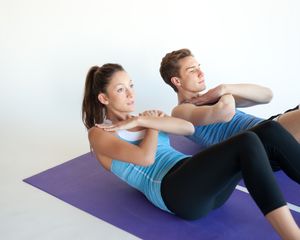Curl-ups
Original Editor - Lilian Ashraf
Top Contributors - Lucinda hampton, Sheik Abdul Khadir, Lilian Ashraf, Daan Vandebriel and Wanda van Niekerk
Description[edit | edit source]
Curl-ups as exercise is one of the most common exercises that target the abdominal muscles. Curl-ups focus on the strengthening and endurance of the abdominal muscles. The abdominal muscles play an important role in the stability of the spine and trunk control.
Curl-ups are performed in the crook-lying, supine position, by lifting the head, arms and upper trunk from the floor. Different curl-ups angles affect the abdominal muscles activity.[1]
Active Muscles[edit | edit source]
The abdominal muscles mainly activated are the rectus abdominis, external oblique, internal oblique and transversus abdominis.[1]
Risk Factors and Significance[edit | edit source]
It is argued that the human spine can only handle a limited number of spine flexion cycles before it leads to spinal disc herniation, which is concluded from in-vitro studies on animal models. But this statement is criticised as the animal models can’t be compared to the human spine in the natural setting due to the many differences such as:
- the ROM of animals and humans spines
- the lack of adaptive and remodelling mechanisms found in the natural in-vivo setting that is not found in-vitro
- lack of fluid inflow to the disc in the in-vitro models
- the period of increased spinal load during spinal flexion exercise is transient that it does not induce fluid loss and the compressive load on the spine decreases in the natural setting due to increase in the intra-abdominal pressure which reduces the compressive forces on the spine.
Spine flexion exercises have significance over the static ones as the spinal motion facilitates nutrients delivery to the intervertebral discs through loading and unloading cycles which is of significant importance as the primary cause of disc degeneration is the age related decrease in the disc nutritional status. Also, flexion-based spinal movements target the rectus abdominis more than other exercises.[2]
Clinical Application[edit | edit source]
To avoid over-stressing the spinal tissues it is recommended that the core strengthening routine does not exceed 60 repetitions of lumbar flexion cycles. For untrained individuals the training should start with a low volume 2 sets of 15 repetitions then progressively increase.
A minimum of 48 hour to 72 hour rest should be allocated between dynamic spinal flexion exercise to allow the spinal tissue, muscles and intervertebral discs to remodel.
Spinal flexion exercise shouldn’t be done until 1 hour of waking up, to decrease the risk of injury.[2]
The angle of the exercise is an important factor in the activity of the abdominal muscles. Maximum activity of the abdominal muscles was reported at 30 degrees eccentric curl-up angle, which is achieved by lifting only the shoulders from the floor.
The activity of the abdominal muscles (rectus abdominis, external oblique and internal oblique) decrease as the curl-up angle increase (moving the body towards the vertical position) due to decrease in the body resistance torque.
The transverses abdominis muscle acts as a corset contributing to the inter-segmental control of the lumbar spine, rather than contributing in trunk flexion.[1]
The speed of the exercise is also an important factor as, the faster the curl-up exercise is performed the higher the muscles' activation level but the lower the motor control level which could lead to increased risk of injury. So it is necessary that the exercise is done at an optimal speed that allows both maximum activation of the abdominal muscles and adequate motor control. Barbado et al.(2015)[3] concluded that for active individuals the fastest cadence is 1 repetition/1 s that could be used but other for other less active populations a slower curl-up speed is recommended to decrease the risk of injury and allow for motor control.[3]
References[edit | edit source]
- ↑ 1.0 1.1 1.2 Ha SY, Shin DC. The effects of curl-up exercise in terms of posture and muscle contraction direction on muscle activity and thickness of trunk muscles. Journal of Back and Musculoskeletal Rehabilitation. 2020 Feb 28(Preprint):1-7.
- ↑ 2.0 2.1 Contreras B, Schoenfeld B. To crunch or not to crunch: An evidence-based examination of spinal flexion exercises, their potential risks, and their applicability to program design. Strength & Conditioning Journal. 2011 Aug 1;33(4):8-18.
- ↑ 3.0 3.1 Barbado D, Elvira JL, Moreno FJ, Vera-Garcia FJ. Effect of performance speed on trunk movement control during the curl-up exercise. Journal of human kinetics. 2015 Jun 1;46(1):29-37.







